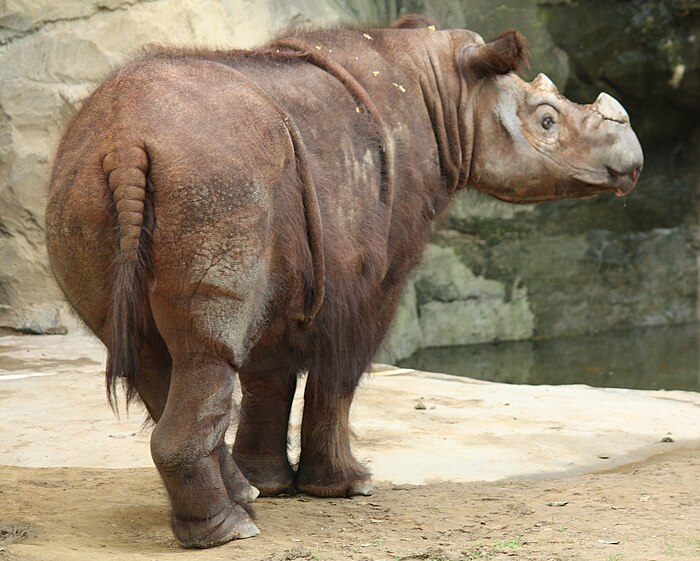Death of captive rhino halts propagation efforts in US
Friday, April 4, 2014

Image: Cincinnati Zoo.
Video: Rfshipman1.
After the death of the Cincinnati Zoo's female Sumatran rhinoceros last Sunday, Dr. Terri Roth, the director of the zoo's research facility specializing in propagation, told Wikinews her organization remains committed to the Sumatran rhinos, an animal that is currently listed by the International Union for the Conservation of Nature as critically endangered.
Suci (pictured left with Roth), the last female in captivity in the United States, died and was one of only two Sumatran rhinos in captivity in the United States.
The number of Sumatran rhinos worldwide is now around 100, according to Roth, who is the vice president of Conservation and Science and the director of Conservation and Research of Endangered Wildlife (CREW) at Cincinnati Zoo & Botanical Garden in Ohio. She told Wikinews her research facility will continue to work with its partners abroad and focus on genetic diversity.
"Realistically, the odds are against us. This is going to be a tough one to save. It's been a roller coaster experience and it’s been a challenge," said Roth.
In the 1980s, Indonesia and the United States entered into a pact to save the animal. According to the plan, Indonesia would enclose captured rhinos in a secure wildlife habitat and provide United States zoos with additional captured rhinos, with the two working together to rebuild the population using the wildlife and captivity. The US program experienced a set back when four out of its seven rhinos died, while zoos were learning to feed them ficus rather than hay.
Roth is an expert on the propagation of the Sumatran rhino. Since the late 1990s, when the Cincinnati Zoo received the last three surviving captive rhinos in the United States, she has studied their mating and pregnancy. This led to the ability to detect pregnancy within sixteen days of conception by ultrasound. After five failed pregnancies, Roth tried hormone treatments of progesterone with success. In 2001, CREW and the Cincinnati Zoo celebrated the first rhino birth in captivity in 112 years, a male named Andalas. The previous Sumatran rhino birth in captivity occurred in 1889 in a zoo in Calcutta, India.
Roth's work with Emi also produced Suci, a female born in 2004; and Harapan, a male born in 2007. Andalas was returned to Indonesia to sire Andatu, another success in the joint Indonesia-US project. Back in the US, the CREW facility would have to partner Suci with her brother Harapan once he reached sexual maturity between six to seven years age. Suci's death on Sunday ended that plan.
"We were hoping to produce another calf, for a number of different reasons. One is that the females do lose fertility over time if they don't get pregnant. So we thought even though were not doing a good genetic match, at least getting her pregnant would preserve her fertility. Although, we never got the opportunity to do that." Roth said.
Indonesia will not be sending the US zoos any more Sumatran rhinos, Roth said, and for Indonesia it is a matter of national pride to rescue the Sumatran rhino.

Dr. Terri Roth tells an audience at the annual Marlene V. Shaw Biology Lecture at the University of Southern Indiana about the work of Center for Conservation and Research of Endangered Wildlife (CREW).
Image: Miharris.
Sources
- Christine Dell'Amore. "One of World's Last Sumatran Rhinos Dies at Cincinnati Zoo" — National Geographic, March 31, 2014
- John Johnston. "Zoo's endangered female Sumatran rhino dies" — Cincinnati.com, March 31, 2014
- Press Release: Wendy Bredhold. "Conservation leader to present Shaw Lecture" — University of Southern Indiana, March 17, 2014
- Elizabeth Kolbert. "Sex and the Single Rhino" — On Earth, March 10, 2014
- Cincinnati Zoo. "Cincinnati Zoo's Rhino Makes History With An Unprecedented Third Calf" — Science Daily, May 3, 2007
External links






